By Robert St. Martin
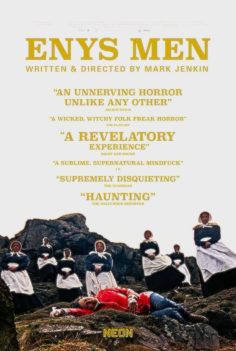 Los Angeles, CA (The Hollywood Times) 4/3/23 – Currently playing at the Laemmle Glendale Theater and several other theatres in Los Angeles is Mark Jenkin’s film Enys Men (UK, 2022) – a psychological drama that deals with supernatural folk horror on an isolated offshore island in Cornwall, the Land’s End of the United Kingdom. The plot centers on a woman identified as the Volunteer (Mary Woodvine) who dwells alone on a rocky isle, studying wildflowers. She lives alone in a vine-covered cottage. A monolithic stone nearby, in a roughly human shape and framed in the gateway to the cottage, alludes to the island legend that Jenkin who is Cornish has said he learned in childhood, of girls turned to stone for singing on the Sabbath. Despite its touches of folk horror, the film’s ambience is more haunting than terrifying.
Los Angeles, CA (The Hollywood Times) 4/3/23 – Currently playing at the Laemmle Glendale Theater and several other theatres in Los Angeles is Mark Jenkin’s film Enys Men (UK, 2022) – a psychological drama that deals with supernatural folk horror on an isolated offshore island in Cornwall, the Land’s End of the United Kingdom. The plot centers on a woman identified as the Volunteer (Mary Woodvine) who dwells alone on a rocky isle, studying wildflowers. She lives alone in a vine-covered cottage. A monolithic stone nearby, in a roughly human shape and framed in the gateway to the cottage, alludes to the island legend that Jenkin who is Cornish has said he learned in childhood, of girls turned to stone for singing on the Sabbath. Despite its touches of folk horror, the film’s ambience is more haunting than terrifying.
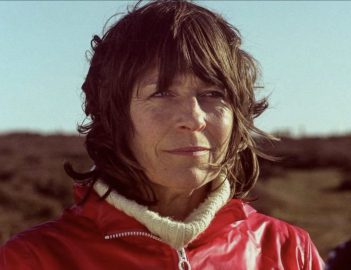 As with 2019’s Bait, Jenkin’s previous feature, Enys Men was shot on 16mm (this time in color), and its sound was post-synced, giving the dialogue a quaint and muffled flatness. Not that there’s much dialogue in the film to muffle. Woodvine’s character, who’s credited as The Volunteer, speaks now and then into a radio: “Petrol’s low,” she says, “and I’m running out of tea.” But most of Enys Men is filled with sounds: Wind, crunching footsteps, a boiling kettle, the burble of static through a speaker, and the sea, as it roars and crashes against the coast.
As with 2019’s Bait, Jenkin’s previous feature, Enys Men was shot on 16mm (this time in color), and its sound was post-synced, giving the dialogue a quaint and muffled flatness. Not that there’s much dialogue in the film to muffle. Woodvine’s character, who’s credited as The Volunteer, speaks now and then into a radio: “Petrol’s low,” she says, “and I’m running out of tea.” But most of Enys Men is filled with sounds: Wind, crunching footsteps, a boiling kettle, the burble of static through a speaker, and the sea, as it roars and crashes against the coast.
 The Volunteer’s days are taken up with repeated rituals. She dons a red rainproof coat, hikes into the hills and plunges a thermometer into the soil near a patch of wild flowers. The she drops a stone into the brooding well of an old tin mine at the foot of a crumbling stone outlook tower, listening for the distant echoes. She walks out into the middle of the field across from her front door, where stands a giant rock in the shape of a pointed spearhead. She’s drawn to the rock as to a magnet. Once back at the cottage, she pulls the chord on a generator, makes a pot of tea, records the date and the temperature of the soil in a diary (along with the words “no change”) and takes a bath before bed, reading a copy of Edward Goldsmith’s influential 1972 environmentalist text A Blueprint for Survival, an ecological warning bell from the period.
The Volunteer’s days are taken up with repeated rituals. She dons a red rainproof coat, hikes into the hills and plunges a thermometer into the soil near a patch of wild flowers. The she drops a stone into the brooding well of an old tin mine at the foot of a crumbling stone outlook tower, listening for the distant echoes. She walks out into the middle of the field across from her front door, where stands a giant rock in the shape of a pointed spearhead. She’s drawn to the rock as to a magnet. Once back at the cottage, she pulls the chord on a generator, makes a pot of tea, records the date and the temperature of the soil in a diary (along with the words “no change”) and takes a bath before bed, reading a copy of Edward Goldsmith’s influential 1972 environmentalist text A Blueprint for Survival, an ecological warning bell from the period.
 The Volunteer’s days are taken up with repeated rituals. Days pass. “No change.” In some ways, her daily routine seems similar to that of Chantal Akerman’s Jeanne Dielman, 23, quai du commerce, 1080 Bruxelles, in the film’s devotion to repetition, in its patience in noticing small changes, in breaking down the routine into something strange, even threatening. There’s tension in the monotony. Until one day, there’s a change. The entire page listing “No change” is in stark contrast to the woman’s daily experiential reality, as well as our experiential reality watching Enys Men.
The Volunteer’s days are taken up with repeated rituals. Days pass. “No change.” In some ways, her daily routine seems similar to that of Chantal Akerman’s Jeanne Dielman, 23, quai du commerce, 1080 Bruxelles, in the film’s devotion to repetition, in its patience in noticing small changes, in breaking down the routine into something strange, even threatening. There’s tension in the monotony. Until one day, there’s a change. The entire page listing “No change” is in stark contrast to the woman’s daily experiential reality, as well as our experiential reality watching Enys Men.
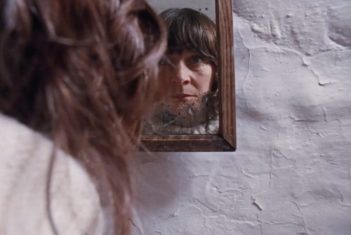 It’s not clear whether or not she is alone on this lonely island. Figures appear. A white-haired man is standing outside at night. A young woman stands on her roof. Or shows up in the next room. There are moments when she is suddenly surrounded by seven girls, all wearing white hoods and white aprons. Underground, in the dripping rocky darkness, Cornish miners cluster, staring up at her, candles attached to their helmets. Ghosts of the past residents of the island? A yellow raincoat seems to suggest a man was here, maybe there was a boat crash. Maybe the pointed rock in the middle of the field is a magnetic force, vibrating with energies past and present. The sound design amplifies the minute (her boots scraping against pebbles), and silence suddenly booms. The radio crackles to life with indecipherable messages.
It’s not clear whether or not she is alone on this lonely island. Figures appear. A white-haired man is standing outside at night. A young woman stands on her roof. Or shows up in the next room. There are moments when she is suddenly surrounded by seven girls, all wearing white hoods and white aprons. Underground, in the dripping rocky darkness, Cornish miners cluster, staring up at her, candles attached to their helmets. Ghosts of the past residents of the island? A yellow raincoat seems to suggest a man was here, maybe there was a boat crash. Maybe the pointed rock in the middle of the field is a magnetic force, vibrating with energies past and present. The sound design amplifies the minute (her boots scraping against pebbles), and silence suddenly booms. The radio crackles to life with indecipherable messages.
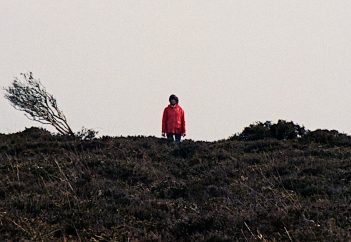 As her research continues, strange occurrences haunt her. A young girl (Flo Crowe) appears in the cottage. She talks to her as if she is her daughter but both share a scar on their torsos. Could they be same woman at difference points in time? Radio broadcasts refer to the mysterious pointed stone structure that appears at disappears at one end of the island. Could this be one of the titular “Enys Men”? After she discovers part of the wreckage of an old lifeboat, she starts to see figures from the past: A group of women in traditional Cornish dress, a preacher, a lifeboat skipper. She ventures into a section of an abandoned tin mine and thinks she sees miners underground.
As her research continues, strange occurrences haunt her. A young girl (Flo Crowe) appears in the cottage. She talks to her as if she is her daughter but both share a scar on their torsos. Could they be same woman at difference points in time? Radio broadcasts refer to the mysterious pointed stone structure that appears at disappears at one end of the island. Could this be one of the titular “Enys Men”? After she discovers part of the wreckage of an old lifeboat, she starts to see figures from the past: A group of women in traditional Cornish dress, a preacher, a lifeboat skipper. She ventures into a section of an abandoned tin mine and thinks she sees miners underground.
 Enys Men is awash with unsettling visions. As lichen appears on the wildflowers, so, too, does it sprout along the pale edge of a scar on the woman’s belly. Later, she returns to the house and finds it ruined, its façade devoured by creepers, only to spot herself walking out the front door. Woodvine reacts to all this with a kind of muted alarm, as though these oddities were faintly known to her. As for the girl (Flo Crowe) who periodically appears, she may well be a younger version of our heroine, or perhaps her child. That is never divulged.
Enys Men is awash with unsettling visions. As lichen appears on the wildflowers, so, too, does it sprout along the pale edge of a scar on the woman’s belly. Later, she returns to the house and finds it ruined, its façade devoured by creepers, only to spot herself walking out the front door. Woodvine reacts to all this with a kind of muted alarm, as though these oddities were faintly known to her. As for the girl (Flo Crowe) who periodically appears, she may well be a younger version of our heroine, or perhaps her child. That is never divulged.
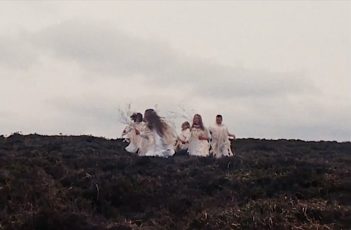 Lichen is a central symbol of Enys Men, deep and rich in its potential multiple meaning. Lichen proliferates across the island, an unstoppable force, breaking apart rocks, and clambering over vertical stony walls. Jenkin goes back to it again and again, shots of it pushing through boulders, sticking out of the sides of the cliff. Lichen is mysterious. It looks like a plant, but it’s not a plant. It’s not fungi, either.
Lichen is a central symbol of Enys Men, deep and rich in its potential multiple meaning. Lichen proliferates across the island, an unstoppable force, breaking apart rocks, and clambering over vertical stony walls. Jenkin goes back to it again and again, shots of it pushing through boulders, sticking out of the sides of the cliff. Lichen is mysterious. It looks like a plant, but it’s not a plant. It’s not fungi, either.
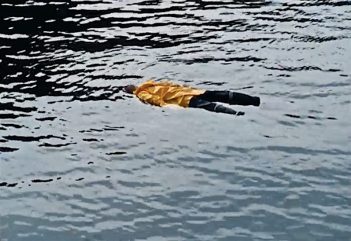 The woman at once does and does not belong on the island, daily peering into a deep well, dropping rocks into it, daring it to swallow her. As with all horror, the space that Jenkin conjures is fundamentally psychological: When he taps into our shared cultural memory, it is like he is moving into the realm of mythology. This is a ghost story of sorts, but not one with too many genre tropes to hold onto. Are the people that she sees real or imaged? Are they ghosts or memories? Much like the role of lichen in the film, time seems frozen, unable to move forward, stuck in an unending repetition where the woman’s very sedentary presence results in being locked into place, lichen literally growing as she is prevented from moving forward.
The woman at once does and does not belong on the island, daily peering into a deep well, dropping rocks into it, daring it to swallow her. As with all horror, the space that Jenkin conjures is fundamentally psychological: When he taps into our shared cultural memory, it is like he is moving into the realm of mythology. This is a ghost story of sorts, but not one with too many genre tropes to hold onto. Are the people that she sees real or imaged? Are they ghosts or memories? Much like the role of lichen in the film, time seems frozen, unable to move forward, stuck in an unending repetition where the woman’s very sedentary presence results in being locked into place, lichen literally growing as she is prevented from moving forward.




